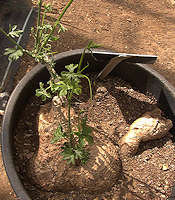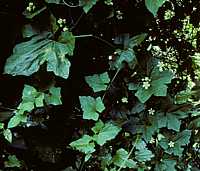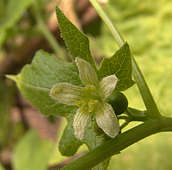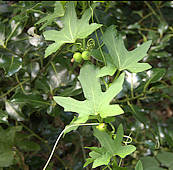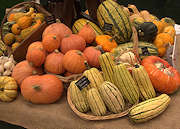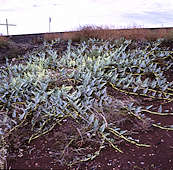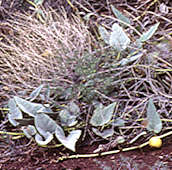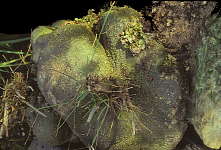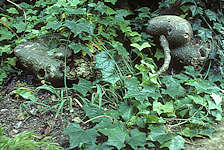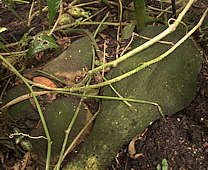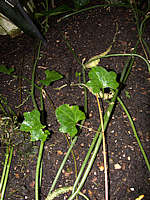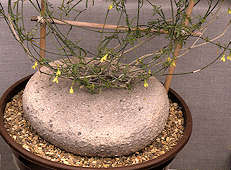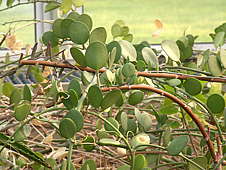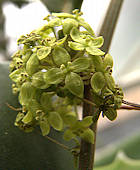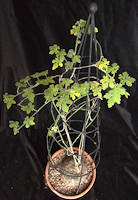The Cucurbitaceae is a medium-sized family of dicotyledenous annual flowering herbs with around 119 genera and over 800 species, mostly from warm climates.
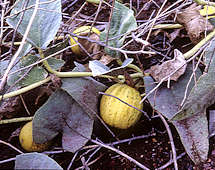 The family takes its name from the genus Cucurbita (squashes, pumpkins). Many species have 5-angled climbing or prostrate stems, often roughened with trichomes, carrying alternate, palmately 5-lobed, veined leaves and coiled tendrils. Cucurbitaceae typically have unisexual yellow or white flowers with 5-fold symmetry and pointed petals, sometimes with petals fused into a funnel, and may be monoecious or dioecious. Fruits are berries (pepo) but may be very large and bottle-shaped containing many seeds, or an explosively dehiscent capsule. A few members of the family are regarded as invasive weeds.
The family takes its name from the genus Cucurbita (squashes, pumpkins). Many species have 5-angled climbing or prostrate stems, often roughened with trichomes, carrying alternate, palmately 5-lobed, veined leaves and coiled tendrils. Cucurbitaceae typically have unisexual yellow or white flowers with 5-fold symmetry and pointed petals, sometimes with petals fused into a funnel, and may be monoecious or dioecious. Fruits are berries (pepo) but may be very large and bottle-shaped containing many seeds, or an explosively dehiscent capsule. A few members of the family are regarded as invasive weeds.
The Cucurbitaceae includes many important food plants (cucumber, melon, pumpkin, squash) as well as useful inedible species (bottle gourds, loofah, ornamental gourds). Members of this family have been cultivated for at least 10,000 years. Some species e.g. Bryonia are also considered to have medicinal properties.
Cucurbitacins (tetracyclic triterpenoids and their glycosides) occur commonly in this family and impart a bitter flavor, discouraging or even poisoning herbivores. Cucurbitacins among the most bitter substances known, have been investigated as anticancer agents, insecticides and beetle attractants.
Most cultivated Cucurbitaceae have been selected to produce low levels of Cucurbitacins although the bitterness of cultivated species may increase in response to environmental stress such as heat or shortage of water. The concentration of cucurbitacins is generally highest in roots and fruit. Asian bitter melons are grown especially for this bitter flavour.
While many species have quite succulent stems and may thus be considered to have a degree of succulence, species of Coccinia, Corallocarpus, Cyclantheropsis, Gerrardanthus, Ibervillea, Kedrostis, Melothria, Momordica, Odosicyos, Seyrigia, Xerosicyos, and Zehneria are generally considered worthy of cultivation as succulent or caudiciform plants. In the interests of sanity, is advisable to introduce these plants to an individual climbing frame early on, as otherwise they may decide to explore the entire greenhouse.
|
Bryonia Linnaeus 1753 (Devil's Turnip)
Ten to twelve species of perrennial climbing vines with thick, fleshy white succulent taproots, from England and Europe to Asia, North Africa, the Canary Islands and South Asia. The island of Crete has its own species B. cretica.
The annual vining stems with large lobed leaves, scramble through bushes and are typically found in woodland margins. Small white flowers are followed by berries containing one or two seeds. The plants are toxic especially the root, ingestion of which can cause death within hours.
Bryony has been used as a medicinal plant for over two-thousand years and was known to Hippocrates (460-380 BC), Dioscorides (De Materia Medica 64 AD) and Pliny the Elder (Historia Naturalis ca. 77 AD). Bryonia dioica has become naturalised in the USA and New Zealand.
|
